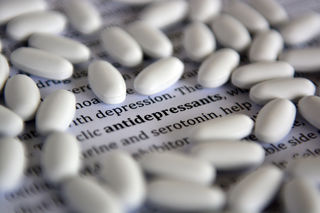SSRIs
Antidepressant Withdrawal Said to Affect “Millions”
A major new study finds that withdrawal syndrome is widespread, often chronic.
Posted October 6, 2018

“More than half (56 percent) of people who attempt to come off antidepressants experience withdrawal effects,” assert the authors of a major new metastudy, and almost half of them (46 percent) describe the effects as “severe.”
“It is not uncommon for the withdrawal effects to last for several weeks or months,” determine James Davies and John Read, both at London-based universities, in the latest issue of Journal of Addictive Behaviors. In that respect, their findings—extrapolated from 23 peer-reviewed studies—contradict guidelines on antidepressants issued by the American Psychiatric Association and the UK's National Institute for Health and Care Excellence, with both claiming that discontinuation issues are usually “mild” and “self-limiting” (resolved in 1-2 weeks).
The metastudy, “A systematic review into the incidence, severity and duration of antidepressant withdrawal effects,” points to a problem far-more widespread and persistent than regulators have acknowledged. Current guidelines “underestimate the severity and duration of antidepressant withdrawal, with significant clinical implications.” At such, the guidelines themselves cannot accurately be seen as evidence-based. They are instead misleading, at odds with the findings, and “in urgent need of correction.”
Given its conclusions, with antidepressant withdrawal understood to "hit millions," the metastudy has drawn national press in the UK, with detailed reports on BBC News and Sky News, and articles in the Guardian, Independent, and MIMS, a site oriented to healthcare professionals. According to the Guardian newspaper, use of antidepressants in the UK “has risen since 2000 by 170 percent, with over seven million adults (16 percent of the adult population) prescribed an antidepressant.”
In the U.S., according to comparable official data, 37 million adults (13 percent of the population) were prescribed antidepressants between 2011 and 2014, a sharp increase from the roughly 8 percent of the population over the age of 12 prescribed the medication during the years 1999-2002. Additionally, whereas in Britain “about half of antidepressant users have been taking the pills for longer than two years,” in the U.S. that number is closer to “five years or more.”
Comments shared by patients included: "It took me two months of hell to come off the antidepressants—was massively harder than I expected." Another wrote, "While there is no doubt I am better on this medication, the adverse effects have been devastating, when I have tried to withdraw, with 'head zaps,' agitation, insomnia and mood changes."
The metastudy found that “withdrawal incidence rates from 14 studies ranged from 27 percent” to as high as “86 percent, with a weighted average of 56 percent.”
Strikingly, that range more or less exactly replicates the findings of Jerrold Rosenbaum and Maurizio Fava, researchers at Massachusetts General Hospital, who in 1997 determined that among patients discontinuing antidepressants, 22 to 78 percent suffered withdrawal symptoms, depending on the drug in question.
In "Rebound Syndrome: When Drug Treatments Fail," a chapter of my 2007 book Shyness: How Normal Behavior Became a Sickness, on the shared story of Paxil and social anxiety disorder, the problem came into focus because of GlaxoSmithKline’s own “product monograph” for the antidepressant (paroxetine hydrochloride), updated by the drug-maker in 2005 after a string of complaints about the drug’s well-documented side effects. Those too bear a striking resemblance to the discontinuation syndrome that Rosenbaum and Fava earlier documented. The side effects range, the drug-maker acknowledged, from "agitation, anxiety, headache, tremor, confusion, diarrhea, nausea, vomiting, and sweating" to "mental status changes that include extreme agitation progressing to delirium and coma.”
The list of "severe agitation-type adverse events" in teens and adults included "self-harm or harm to others," GSK continued, as well as "disinhibition, emotional lability, unpredictable mood swings, hostility, aggression, depersonalization, [and] akathisia," a serious condition marked by extreme motor restlessness. Still, in light of the most-recent evidence, the drug-maker can be said to have minimized the problem by putting the prevalence rates for antidepressant withdrawal at 20 percent, or one patient in five, rather than (as currently) a weighted mean of 56 percent with an upper threshold of 78-86 percent, according to the two metastudies.
Overall, Davies and Read’s metastudy points to far-greater prevalence rates and far-more serious and longer-lasting discontinuation symptoms than current guidelines advise, with the withdrawal syndrome often lasting for weeks, even entire months. In the process, the authors upend long-standing assumptions that the drugs are largely well-tolerated, with antidepressant withdrawal generally rare, mild, and “self-limiting” (resolved in 1-2 weeks). On the contrary, tolerance for the drugs is shown to be much lower than assumed, with discontinuation problems more frequent and more chronic than two sets of national guidelines suggest.
Given the scale and gravity of these results, patients concerned about the drugs’ adverse effects are strongly advised NOT to terminate treatment abruptly, but instead to taper carefully and gradually by microdoses over a course of several months, always in consultation with their doctor, to ensure their own safety. Peer-reviewed, specialist information on discontinuation issues is available on the website Surviving Antidepressants, with a forum specifically on “Tapering.” Much of the early bibliography on withdrawal is also detailed here, in this 2011 post on “Side Effects.”
References
Davies, J., and J. Read (2018), "A systematic review into the incidence, severity and duration of antidepressant withdrawal effects: Are guidelines evidence-based?" J. Addictive Behaviors: https://doi.org/10.1016/j.addbeh.2018.08.027




